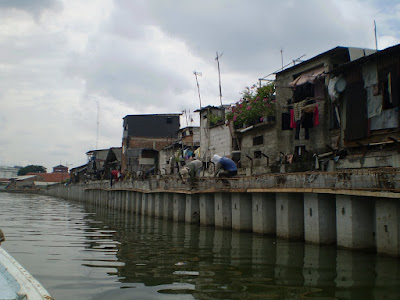We decided to make use of the weekend and experience Indonesia outside of Jakarta, so some of the school's administrators took us out to a city called Bogor. Like everywhere else we go in Indonesia, we were taken their by our dedicated driver. All westerners in Jakarta, and seemingly most middle-class or wealthier individuals here, have their own full time driver, which goes along with the general trend here of having multiple assistants, but I will go into that in a future post.
 |
| A rice paddy along the highway. |
Bogor is about an hour and a half drive from Jakarta on the highway. Unlike the normal roads in Jakarta, the toll highways are very reminiscent of highways in the western world, with cars travelling fast, and few motorcycles. If it were not for the rice paddies and jungle environment, it would be easy to think you were in the US while driving along them.
 |
| Administration building of the botanical gardens. |
 |
| Map of the gardens, with the presidential palace in the green area. |
When we got to Bogor, we hired a tour guide to take us on a tour of the botanical gardens, which is also home to the Indonesian president's palace. The palace grounds are home to a herd of deer, apparently the descendants of a pair of deer gifted to Indonesia by Gandhi. The area immediately around the palace is also home to a collection of replicas of famous statues from Europe.
 |
| Replica of the famous Little Mermaid statue from Copenhagen, in front of the presidential palace. |
 |
| Me in front of the presidential palace, complete with deer in the background. |
 |
| Replica of a Swedish statue in front of the presidential palace. |
Our tour of the gardens took us past a huge collection of exotic trees, flowers, and other plants, including some of the tallest bamboo I have ever seen. The gardens are incredibly beautiful and a world away from the hustle, pollution, and crowds of Jakarta.
 |
| A huge, hundred-year-old tree. They call these trees the redwoods of Indonesia because of how big they get. |
 |
| Gardens in the park. |
 |
| "Sausage fruit" trees. |
 |
| The biggest spider I have ever seen, weaving its web. The spider was easily the size of my fist. |
 |
| Flowers in the garden. |
 |
| A plant which the locals literally use as umbrellas. |
Some local university students who were learning English, politely asked us if they could interview us for a project. We all helped them out, answering their questions about America and which movie stars we liked the best. Not half an hour later, another group of students also approached us, and we gave another interview on camera. In some English class in Bogor, I am going to be famous!
 |
| One of the themed gardens at the park. |
At the end of our trek around the gardens, we relaxed in a cafe and drank delicious fruit juices. I had an amazing avocado juice, which of course reminded me of avocado milkshakes, my favorite (though hard-to-find) milkshake flavor. Well prepared fruit juices here seem to have the same place in the culture that cocktails do in western culture, probably due to the fact that most Muslims don't drink hard liquor.
 |
| Park around the cafe in the botanical gardens. |
 |
| Real coconut drink that my coworker drank. |
 |
| My delicious avocado juice with coffee syrup. |






















































